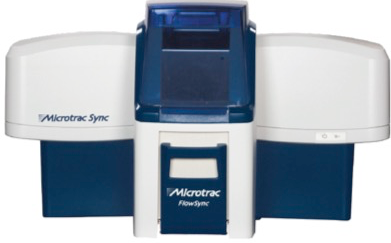As print head and inkjet technology are progressing, the demand for characterisation of inks regarding their pigment size, single oversized grains and colloidal stability is increasing. The size of pigments has an impact on factors like printability, print head blockages, sharpness of texture, optical density and color gamut. Microtrac introduces a new technology which combines, for the first time, data from laser diffraction and Dynamic Image Analysis. The size distribution of the inkjet ink is measured by the laser technology, while the optical image detects size and shape of larger particles. This enables users to monitor the milling process, to assess the final product and to detect single oversized particles or clumps which cause a risk for blockages.
Figure 1. FlowSync machine
LD Technology
Smaller particles scatter coherent light over wider angles and at lower intensities than do larger particles. In LD, a coherent laser beam scatters light focused on a flowing stream of particles across multiple diode detectors situated at angles from 0 to over 163 degrees from the incident light beam. The resulting light flux distribution measured by the detectors is used to calculate the size distribution which generated it.
DIA Technology
Particles in a flowing stream, back lit by a high speed strobe light, are photographed by a high resolution digital camera to create a video file of images of the flowing particles. The pixel size of the camera and the number of pixels in the image are used to calculate a large number of size and shape parameters, along with a measure of light intensity from the particles.
Figure 2. Size distribution of inkjet ink pigments, as measured by diffraction, given in micrometer
Figure 3. Over-grains detected by Dynamic Image Analysis, with size in micrometer, which were not detected by the laser measurement.
Sample dispersion
Before a sample is measured by LD or DIA, it needs to be dispersed properly in its native fluid. The new FlowSync’s (Figure 1) automated filling, de–aerating, pre-circulating and circulating operation means each sample is handled with a consistency that improves the repeatability of particle size distribution and shape data. Its fluid dynamics feature a built-in turbulence to ensure that all particles are moving constantly within the flow, negating the need for an external stirrer. The wash feature in the sample vessel ensures the walls of the vessel are thoroughly cleaned during the “rinse” cycle. This eliminates “carry-over” of material during repeated measurements.
Summary:
- Laser Diffraction (LD) technology has for decades been the most used particle size measurement technology in industry and R&D. It’s fast, easy, robust, and well understood and established.
- Dynamic Image Analysis (DIA) technology is rapidly expanding in use to characterize the morphology, sizes and shapes, of particulate systems. For inkjets, it offers the capability to detect overgrains which might escape the laser measurement.
- A new instrument from Microtrac called "SYNC“ combines LD and DIA technologies into a single unit to simultaneously measure the same sample stream, in the same sample cell, in one measurement.
by Thomas Benen, Sales Manager, Microtrac GmbH.
Further details of this work will be presented by Dr Benen at the IMI Europe Inkjet Development Conference, 17-18 April 2018 in Frankfurt, Germany.



